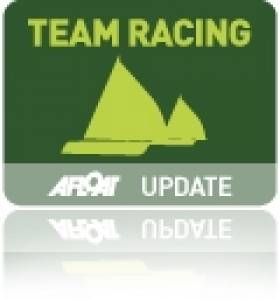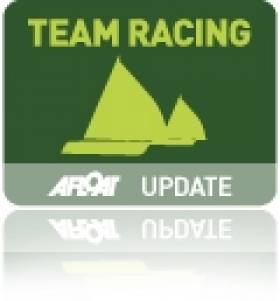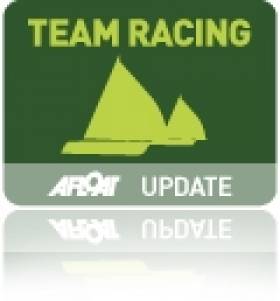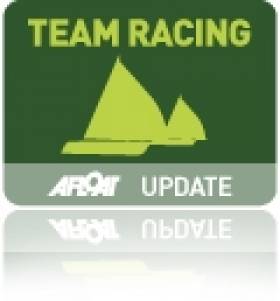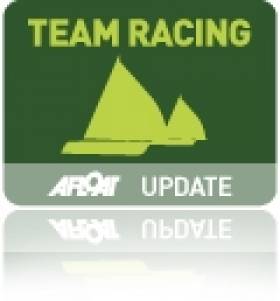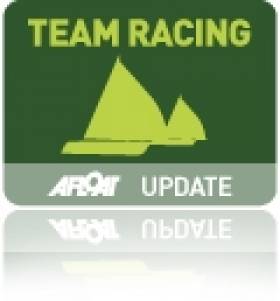Displaying items by tag: Team Racing
UCD 1 Victorious at IUSA Easterns in Kerry
The 24 teams from UCD, DCU, DIT, CIT, UCC, NUIG, Queens and Trinity were greeted with sunny blue skies as they arrive down to Dingle Sailing Club on Saturday morning the 17th of October to compete in the first day of the 2015 IUSA Easterns. The winds were light in the harbour and struggling to reach five knots. While the boats were being rigged, course being set and committee getting in position the breeze began to rise as if to welcome the sailors to the waters of Dingle.
The races got off to a slow start due to problems arising with the jury boats in the flooding tide, making areas of the course to shallow to sail in. Once these problems were remedied the races flew by. Locals and tourists looked on from the grass area as they were treated to watch very close racing. As the sun began to set and the temperatures dropped the committee called racing for the day after 61 tight races. At the end of the day the leaders of the gold, silver and bronze round robins were UCC1, UCD3 and UCD5 respectively.
An earlier first gun saw the teams on the water for 9:30am on Sunday morning and racing got underway immediately. The racing went straight into the quarterfinals with best of 3 matches for the gold and silver fleet and best of one for the bronze fleet. The finals were UCD1 versus CIT1 in the gold fleet, TCD3 versus TCD4 in the silver fleet, and TCD5 versus TCD6 in the bronze fleet with UCD1, TCD3 and TCD5 all coming out victorious.
Royal St. George Yacht Club in Dun Laoghaire will follow up its inaugural Elmo Trophy Team Racing trophy next month when the country's largest yacht club stages the Irish Team Racing Championships 2015 from 7th–8th November.
The event is for three boat teams and will be sailed in RSt.GYC supplied Firefly dinghies.
ISA Medals will be awarded to the first three Irish teams, and to the first Irish Youth team (subject to a minimum of three entries). In addition, the first Irish teams in each category may be selected to represent Ireland at any International team racing event in 2016.
More details downloadable below.
Irish University Sailing Team Sixth in Collegiate Cup Regatta
As students prepare to head back to school, the Irish Collegiate Sailing Team is celebrating recent success in one of it’s first U.S. regattas of the season; the Laser Performance Collegiate Cup, sailed in 420 dinghies last week.
The regatta, which kicked off on the 25th of August on Long Island Sound in Connecticut, USA, consisted of eight teams from around the world who all came to attend what is considered the first collegiate level international regatta with both team and fleet racing components. The regatta, organised by LaserPerformance and sponsored by FitAid and Redbull, was generously hosted by the Yale Corinthian Yacht Club, who provided the boats.
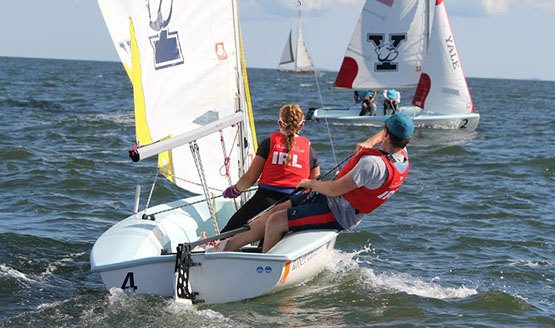
The first two days of the event were set aside as coached clinics so that the sailors could get used to the new boats and practice their team racing skills, a sector of competitive sailing that several of the sailors were experiencing for the first time. Among these coaches was Anna Tunnicliffe, four time U.S. Sailing’s Rolex Yachtswoman of the Year and 2008 Olympic Gold Medalist in the Laser Radial Class, among other titles. Irish sailor Caoimhe Tyndall commented, “Anna's professional instruction proved to be extremely beneficial, as each sailor noticeably improved as the regatta progressed…Anna provided the competitors with an immense amount of sailing knowledge.”
Both clinic days started out with 5-7 knots from the west and eventually shifted around to the south, building to 10-15 knots. The Irish Team felt that this was the perfect wind for team racing and were able to get some good quality races off, especially against the ever competitive Italians.
West Kirby Sailing Club narrowly beat the RSGYC Green of the home club 2-1 in the final to win the first Elmo team racing Trophy.
8 teams of under 18 sailors took part, quickly getting to grips with the equally matched fleet of firefly dinghies. Blue skies and fresh breezes on Saturday saw Storm sails fitted as the teams got into their strides.
The experienced and fast team from Schull set the early pace and dominated the first round robin where each team sailed 7 races.
Joining Schull in the Top four and thus into the Gold League were West Kirby and RSGYC GREEN and RSGYC RED. Just missing out and into Silver were Sutton Dinghy Club who were new to Fireflies and to team racing – more to come from them in the Future.

Elmo Trophy Winners
Sunday morning saw gentle breezes and a chance for the young flyers from Bray to post wins on the scoreboard. The weather co-operated all day and allowed the completion of a second round of Gold and Silver racing to be completed.
RSGYC Green won a three way tie to finish as top seeds for the Semi Final knock-outs. RSGYC RED and RSGYC Blue battled it out for the fourth seed with RSGYC RED emerging victorious.
The first Semi Finals saw West Kirby eliminate Schull 2-0 and RSGYC Green knocking out RSGYC RED by the same score. The final was closely fought with WKSC taking the first race only for RSGYC Green to stack the favoured pin in Race 2 and use their speed to sail off with a 1-2 victory. West Kirby showed their experience in the deciding race by dominating the pre-start and establishing a 1-2 combination at the first mark which they would never relinquish. Schull went back to West Cork with the consolation of third place after winning the petit final 2-0.
Special thanks go to the Race Team and Umpires whose efficiency saw each team sail at least 13 races over the weekend.
Final Results
1st West Kirby Sailing Club
Hollie Marston Tom James Ella Marston Henry Hughes Hannah Owen Alex Colquit
2nd RSGYC Green
Conor O'Beirne Molly Boyne Sean Donnelly Sarah Fogarty Patrick Cahill Emily Arrowsmith
3rd Schull
Isaac Mccarthy-Fisher Rosa Lyden Noah Mccarthy-Fisher Harry Durcan Florence Lyden Anna O'Regan
4th RSGYC Red
5th RSGYC Blue
6th Sutton Dinghy Club
7th Bray Sailing Club
8th National Yacht Club
Forum For Irish Team Racing Discussion Opens Online
#teamracingforum – News that the Optimist dinghy class in Ireland is once again organising a team racing event, together with the announcement of plans for junior event in the Royal St George and the continuing development of 2K team racing in Europe confirm that team racing offers competitive sailing for all ages. With this new impetus the Irish Team Racing Association have set up a forum to allow 'in depth discussion' of a large number of topics regarding team racing and its development in Ireland.
The forum is reserved for active participants in team racing organised by ITRA. Delegates from IUSA, the Irish National Schools Sailing Association will be invited to participate if they do not qualify for access directly. As membership of ITRA is one topic that needs to be addressed access to this forum is limited to sailors, race committee and umpires who took part in the ITRA Nationals in 2013 and 2014.
The forum registration process is here
RYA National Team Racing Championship Won By Hoosiers
#teamracing – The Royal Forth Hoosiers (Tim Saxton, Rob Friend, Mark Powell, Isobel Walker, George Clark, Holly Scott) were worthy winners of the RYA National Team Racing Championship hosted by the UK Team Racing Association and Rutland SC on 21/22 March.
24 of the best team racing teams from across the UK were competing at the event, including the recently selected GBR squad for the forthcoming ISAF Team Racing World Championship, which is also being hosted by Rutland SC in July.
The competition started in a fresh, force 4/5 breeze on Saturday, necessitating the use of cut down mainsails on the fleets of 12–foot Firefly dinghies.
The first stage of the Championship consisted of four, seeded leagues, each comprising six teams. After 60 races, the fleet was reclassified for the second stage into Gold, Silver and Bronze leagues of eight teams.
The Championship was decided on the results of the second stage races that had been sailed. The Hoosiers were convincing winners, having not lost a race throughout the competition, and were presented the Prince Philip Trophy.
The next major team racing competition will be the Wilson Trophy (the unofficial British Open Team Racing Championship), which is being hosted by the West Kirby SC on the Wirral, near Liverpool, on the 8-10 May 2015.
More here
#teamracing – The second day of racing at the Munster Schools Team Racing Championships was a huge contrast to the first day of racing. Last week's racing racing took place in light to medium 6 to 10 knots of wind in glorious sunshine. The second round robin of 36 races saw some great racing with Schull Sharks coming out on top losing just one race out of the two round robins. The second and third spots were filled by PBC 2 and PBC 1.
Competition was intense for the Munster places and all competitors are now looking forward to the Nationals when no doubt the level of competition will be upped again.
Now qualified for the Nationals that will be sailed at Schull on April 18th and 19th next are:
1st Schull Sharks: Isaac McCarthy, Florence Lyden, Gleb Romantchik, Sinead Barnett, Anna O'Regan, Rosa Lyden
2nd PBC 2: Harry Durcan, Ronan Cournane, Billy Duane, Ronan Walsh, Charlie Moloney, Mark Cunningham
3rd PBC 1: Johnny Durcan, Peter McCann, Seafra Guilfoyle, Criofan Guilfoyle, Arran Walsh, Michael Carroll
4th CBC: Grattan Roberts, Thomas McGrath, Richard McGinley, Luke McGrath, Cian Jones, Shane Dunlea,
5th Rochestown College: Eoin Lyden, Brian Stokes, Eoghan O'Regan, Cathal O'Regan, Patrick Daly, Chris Bateman,
#teamracing – This year, Trinity Sailing hosted the annual Colour's match at Grand Canal Dock, where the six sailing teams of UCD and Trinity competed against each other writes Amelia O'Keeffe of Trinity Sailing Club.
Traditionally the event takes place in Dun Laoghaire harbour but after the success of last year's match, which took place on the River Liffey, Trinity decided to take the event to another new and unique location – Grand Canal Dock. The event has been made possible by the kind support of Dubarry of Ireland.
Racing began at 9.30a.m. on Saturday March 21st. The weather was ideal for sailing, with a strong Easterly breeze and lots of sunshine.
TCD6 and UCD6 took to the water first in a best of five head-to-head. UCD secured a win with 3 races won to 2.
Then it was TCD5's turn to take on UCD5, where Trinity secured a great victory with a 3-0 win.
Due to time constraints we then moved in to best of three racing. UCD4 beat TCD4 with a 2-0 victory. Next the third teams took to the water and managed to win their first two races securing another win for Trinity.
TCD2 vs. UCD2 saw the racing return to best of five. TCD2 won with a 3-1 score.
The next two sets of races were the traditional Alumni and Ladies' races. UCD Alumni beat TCD 2-0 in a best of three and the Ladies of UCD beat those of Trinity with a 1,2,3 in a single race.
The last racing of the day would be the decider of the winner of Colours' 15 when the two first teams raced against each other. TCD1 won the first race with a 1,36, following it up with a 1,2,5 finish in the second race. UCD fought back in the third race, securing a win with a 1,2,6. Everything was very tense as the teams crossed the start line for the next race. Trinity managed to start with an outstanding 1,2,3, finishing with a 1,2,4 securing the title for the second year in a row of Colours' winners.
We had plenty of spectators come down to watch the racing and listen to music from Nick Nowlan and Chris Raymond. Lunch deals were kindly provided by Donnybrook Fair. The view of the racing was excellent, with even the Viking Splash tours stopping to watch!
An event such as this does not happen on its own so there are many people we need to thank for making this happen including Dubarry of Ireland for sponsoring the event, Harry Crosbey and Michael O'Leary for their help in securing the on-land licenses for the event, Mark Clarke, the dockmaster, for his help with getting the ribs through the locks and managing the Viking Splash, Shane Anderson from Waterways Ireland for the on-the-water licenses, DUCAC for their support in all aspects of organising the event and the many people we had helping on the day including the jury, committee and finish boats, photographers and helpers.
We hope that the event highlighted the potential and the importance of University racing and Team Racing in Ireland and that all who took part in the event or came down to watch enjoyed it, we certainly did!
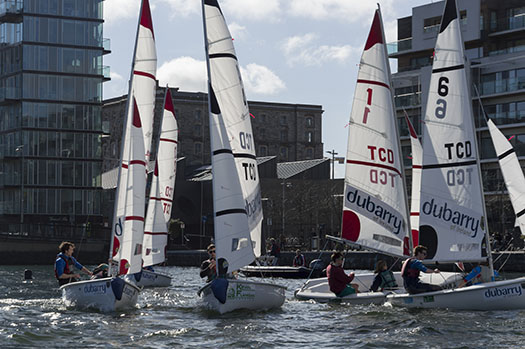
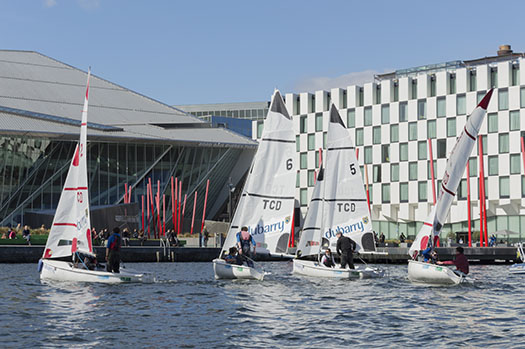
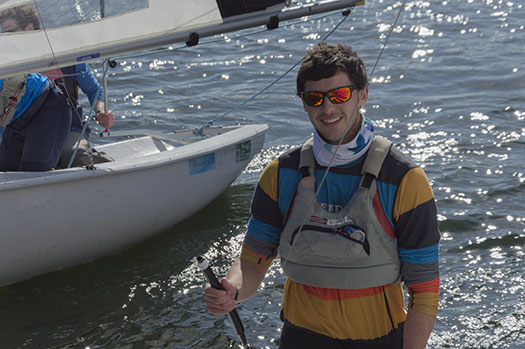
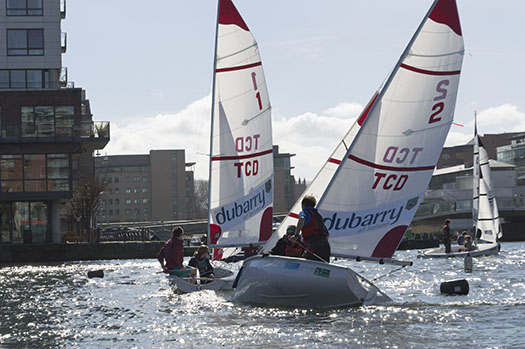

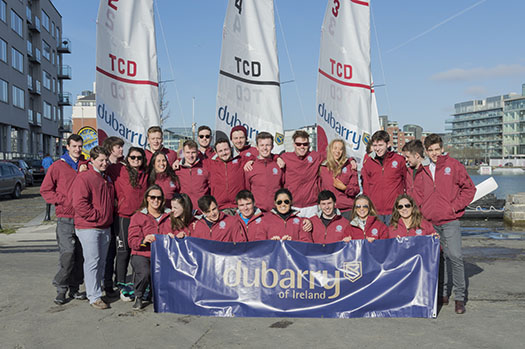


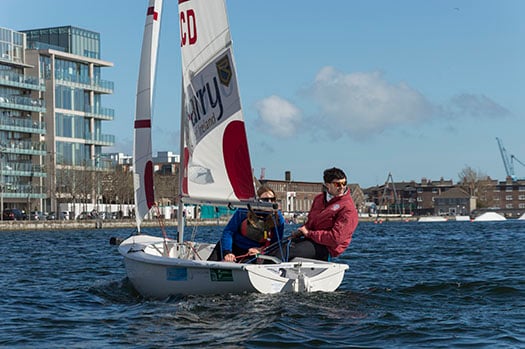
UCC Reign as Intervarsity Irish Champions
#teamrace – A very exciting and eventful finals series on Saturday, produced an all UCC final, with UCC1 facing off against UCC2. UCC1 won the first three races of the five race final which saw them being crowned Intervarsity Champions for 2014/2015. From the 26th to the 28th of February UCC Sailing Club hosted the IUSA Intervarsity Championships in the Fastnet Marine Outdoor Education Centre, Schull, Co. Cork. The event consisted of three days of highly competitive racing, despite the extremely heavy conditions. Days one and two saw 28 teams racing in three fleets (Gold, Silver and Bronze), which were selected according to team rankings based on the results of the regional events this season.
On day three, the top 16 teams were selected for the finals series, with the winners of each respective race going on to quarter finals, namely University College Cork 1, University College Cork 2, University College Dublin 1, University College Dublin 4, Trinity College Dublin 1, Scottish University Sailing Association, Loughborough University and Cork Institute of Technology 1.
Sadly, due to the increasingly adverse conditions, the race committee were forced to cancel the Silver and Bronze fleet finals and therefore their prizes were awarded based on the standings from the first two days of racing.
The semi-finals saw defending champions UCD1 narrowly lose out to UCC2 and UCC1 overcome SUSA. As a result, the host club found themselves in an all-UCC final, with UCC1 coming out on top, securing victory over their fellow club members by winning the first three of the best-of-five final.
The awards ceremony took place on Saturday night, with the National University of Ireland Galway being awarded Best Club of the Year for their tremendous efforts in promoting and enhancing their club over the past year, and for being incredibly compliant and helpful to any club who hosted events during the season. Event of the Year was awarded to UCD who hosted the Eastern Championships in Blessington earlier in the year. First Year Sailor of the Year was awarded to newly crowned Intervarsity champion, Fionn Lyden of UCC1. Sailor of the year went to the very deserving Philip Doran of UCD1.
On behalf of UCC Sailing Club I would like to thank everybody who partook in the organisation and running of this event, in particular the Irish University Sailing Association committee, the volunteers (including many UCCSC alumni), the race committee – lead by Denis Quinlan, the umpires, everyone in the Fastnet Marine Outdoor Education Centre, the community of Schull, and our fellow university clubs.
Gold Fleet prize winning teams:
UCC1: Cian O' Regan, Fionn Lyden, Aidan McLaverty, Eimear O' Leary, Dave Healy, Niamh Ní Chonghaile
UCC2: Ross Murray, Brendan Lyden, Conor Lyden, Liam Manning, Chloe Crosbie, Emma Geary
UCD1: Philip Doran, Conor Murphy, Rory Lynch, Tara Flood, Clíodhna Connolly, Ally Morehead
Irish Team Racing Association To Select World Championship Teams
#teamracing – The ISAF Team Racing Worlds will be sailed in Rutland UK on 19th-24th July 2015. The ISA has already reserved places for an open team and a youth team. Other places may become available during the entry process.
The Irish Team Racing Association will select Open and Youth teams to represent Ireland at this event.
Teams shall consist of six sailors, including at least one male and one female competitor. The age limit for Youth teams is under 19 on 31st December 2015. All competitors must be eligible to represent Ireland under ISAF Eligibility (Regulation 19).
On the basis of information supplied by the candidate teams the Selection Committee will select a number of teams to compete in a trial event. Criteria for selection will include consideration of the individual sailing CVs of all six team members, and results in team racing in Ireland and abroad, particularly in 2013 and 2014. Preference will be given to teams that have already demonstrated their capacity to compete in international competitions.
A one day, multiple round robin event will be sailed. This event will be sailed in Fireflies, and the event is planned for Saturday 14th February in the Royal St George Y.C. Dun Laoghaire.
Selected teams will be nominated by the Irish Team Racing Association for approval by the Irish Sailing Association to represent Ireland at the ISAF Team Racing Worlds.




























